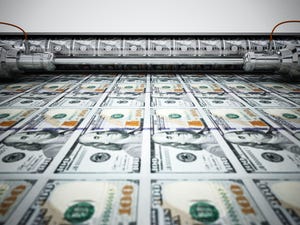AT&T's $85B Time Warner Takeover Is a Media Game Changer
The US telco giant has taken the boldest move into content ownership imaginable. If the deal goes ahead, nothing will be the same again.

In Game of Thrones, one of HBO's most successful productions, rival houses form alliances and fight for control of the fictional land of Westeros. It could describe the clashes and counterattacks that have become a regular feature of the US communications landscape, where industry giants are battling one another for the consumer dollar. In that real-world game of thrones, AT&T's just-announced $85 billion takeover of HBO owner Time Warner is an empire-building move as dramatic as anything in the TV series.
Rumors that a deal was in the works began circulating on Friday, when sources told Bloomberg that AT&T Inc. (NYSE: T), one of the largest telcos in the US, was holding informal discussions with Time Warner Inc. (NYSE: TWX), which owns a range of high-profile media properties besides HBO, including Warner Bros Entertainment, CNN and Cartoon Network. By late Friday, a full-blown takeover seemed imminent. It was confirmed in an official statement from AT&T over the weekend. (See That Was Quick: AT&T to Buy Time Warner for $85B and AT&T & Time Warner in Merger Talks – Report.)
In a cash-and-stock transaction, AT&T is to pay $107.50 for each Time Warner share, leaving Time Warner's shareholders with about 15% of the combined company. That fee is roughly a fifth more than the current price of the stock, which gained about 8% in value on Friday, and about 36% more than it was worth midweek, before takeover speculation began. In total, that means AT&T will pay about $85.4 billion in pure "equity" for the Time Warner business. But including debts, the takeover will cost as much as $108.7 billion.
AT&T obviously believes such a jaw-dropping fee is justified. "Premium content always wins," said Randall Stephenson, AT&T's chairman and CEO, in the company statement. "We'll have the world's best premium content with the networks to deliver it to every screen."
The desire for premium content is nothing unusual. As the bottom has fallen out of the old-fashioned voice-and-text-messaging business, operators have needed access to attractive content offerings to persuade consumers that high-speed Internet connectivity is worthwhile. Competition from cable companies that have moved in the opposite direction -- from TV into broadband -- has forced telcos to add video to the service mix or risk losing out. An appetite for the "quad-play," which lumps voice, mobile, broadband and TV in a single package and bill, is taking hold in some parts of the world, especially where disposable incomes are being squeezed.
Want to know more about the impact of Web services on the pay-TV sector? Check out our dedicated OTT services content channel here on Light Reading.
Yet AT&T's takeover of Time Warner betokens much grander ambitions. Last year, the operator spent $48.5 billion on DirecTV Group Inc. (NYSE: DTV), a satellite company with a huge pay-TV audience, having previously catered to a much smaller group of TV customers on its U-verse broadband platform. It is no longer satisfied with "aggregating" content through piecemeal deals with media companies -- a strategy that still prevails elsewhere. Like a conquering Westerosi warlord, it is dispensing with the negotiations and partnerships and taking full control with its Time Warner acquisition.
With a broader line-up of popular programs, AT&T should certainly be able to fortify its DirecTV service and lure more pay-TV customers from its rivals. That business has already gained more than 1.2 million subscribers since AT&T's takeover, giving it nearly 20.8 million customers at the end of September, nearly as many as the 22.3 million served by cable giant Comcast Corp. (Nasdaq: CMCSA, CMCSK) in June. Including the 4.5 million TV customers on its U-verse service, AT&T is already bigger than Comcast in terms of TV subscriber numbers, but it will be keen to extend its lead.
As cable companies plot their own moves into the US mobile market, AT&T also hopes to give consumers less reason to hunt for a mobile alternative. Time Warner content will be delivered across a range of technology platforms, AT&T has made abundantly clear, including on the smartphone screens that are rarely out of customer hands. In theory, AT&T will be able to offer a full quad-play service that includes some of the world's most in-demand content for a single, affordable fee. "A big customer pain point is paying for content once but not being able to access it on any device, anywhere," said Stephenson. "Our goal is to solve that." Lacking the same network and content resources, rivals will struggle to compete.
Next page: A dance with dragons
A dance with dragons
Yet the deal's success is by no means assured. AT&T might not face the dragons that are an ever-present threat in Game of Thrones, but it will have to contend with the usual regulatory beasts, and it has already encountered political opposition from US presidential candidate Donald Trump, who has reportedly described the takeover "as an example of the power structure I'm fighting," according to Reuters. Its closest parallel is Comcast's recent acquisition of NBC Universal, but the cable company had to make some painful concessions before regulators allowed it to buy a majority stake in 2011 (it has subsequently taken full control of NBC Universal). An obvious concern is that AT&T could try to prevent other service providers from gaining affordable access to its content crown jewels.
The transaction might also appear to be at odds with the "disaggregation" that is occurring in the market, as cable subscribers "cut the cord" and opt for lower-cost and slimmer content packages from so-called over-the-top (OTT) providers. Instead of buying expensive service bundles, including a TV channel for every day of the year, many consumers are taking a standalone broadband service along with a low-cost subscription to Netflix or Amazon, which stream content over Internet connections to fixed and mobile devices.
In fact, competition from those players, besides rivalry from traditional competitors, could partly explain AT&T's move. As Netflix Inc. (Nasdaq: NFLX) and Amazon.com Inc. (Nasdaq: AMZN) have grown, they have attached more importance to the development of their own exclusive content than to aggregating movies and programs made by others. Starring Hollywood actor Kevin Spacey, Netflix's House of Cards has proven a hit on the scale of some HBO offerings. In the meantime, the OTT players have been forming tie-ups with operators, posing a challenge to service providers that have not taken action on the premium content front.
The Time Warner takeover would allow AT&T to cover all of the various bases. Its own OTT offering, under the DirecTV Now brand, is due for launch, while Time Warner has already introduced an HBO Now service in response to the Netflix effect. Service bundling should satisfy consumers who still want fat, all-inclusive deals. And as Netflix funnels bigger sums into content production, AT&T will be able to respond by channeling investments into the programs from the Time Warner stable. (See AT&T Starts DirecTV Era With New Bundles.)
Being sucked into a costly battle on content creation is a clear risk, however. Time Warner reported flattish operating income for its April-to-June quarter, compared with the year-earlier period, blaming "increased programming costs" for declines at its HBO and Turner divisions. Overall revenues, meanwhile, fell by 5%, to $7 billion, because of a sales slump at Warner Bros. AT&T believes that content ownership will create new advertising opportunities to help pay for content creation, but it has not shared any details.
The operator sees a number of broader financial and business benefits arising from the merger, which it hopes to complete before the end of 2017. The tie-up is expected to be accretive to both earnings and free cash flow in the first year and to generate $1 billion in annual run rate cost synergies within three years. Moreover, AT&T anticipates "incremental revenue opportunities that neither company could obtain on a standalone basis." Reporting July-to-September earnings at the same time it announced the Time Warner deal, AT&T saw its operating income rise by 8.2% compared with the year-earlier period, to $6.4 billion, with free cash flow dropping by 6.5%, to $5.2 billion. Revenues were up 4.6%, to $40.9 billion.
The merger should also help to reduce capital intensity. AT&T invested about 14.4% of its revenues in capital expenditure during the third quarter due to heavy infrastructure spending. Time Warner's equivalent figure was just 2.3%. Conversely, it will increase AT&T's net debt to about 2.5 times its earnings (before interest, taxation, depreciation and amortization), from a ratio of about 2.3 earlier this year. From a borrowing perspective, that will make AT&T look even more like some of Europe's heavily indebted telco incumbents.
AT&T evidently has a long way to go before the deal is sealed, and some analysts are said to have given the merger only a 50% chance of succeeding. This could be a drawn-out campaign, then, and one that prompts both Trump-like vitriol and countermoves by AT&T's rivals. Should it go ahead, it will make AT&T a force that is hard to contain.
— Iain Morris, 

 , News Editor, Light Reading
, News Editor, Light Reading
About the Author(s)
You May Also Like












